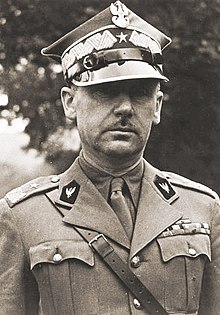Stanisław Kopański
| General Stanisław Kopański |
|
|---|---|

General Stanisław Kopański
|
|
| General Inspector of the Armed Forces | |
|
In office 1972 – March 23, 1976 |
|
| Preceded by | Stefan Dembiński |
| Succeeded by | Zygmunt Bohusz-Szyszko |
|
Chief of the Polish General Staff Polish government-in-exile |
|
|
In office 21 July, 1943 – 3 September, 1946 |
|
| Preceded by | Tadeusz Klimecki |
| Succeeded by | Władysław Korczyc |
| Personal details | |
| Born |
May 19, 1895 St. Petersburg, Russian Empire |
| Died | March 23, 1976 (aged 80) London, England |
| Profession | Officer and engineer |
| Awards |
|
| Military service | |
| Allegiance |
|
| Years of service | From 1917 |
| Rank | General |
| Commands | Polish Armed Forces |
| Battles/wars |
World War I Polish-Soviet War World War II |
General Stanisław Kopański (1895–1976) was a Polish military commander, politician, diplomat, an engineer and one of the best-educated Polish officers of the time, serving with distinction during World War II. He is best known as the creator and commander of the Polish Independent Carpathian Brigade and Polish 3rd Carpathian Infantry Division.
Between the years 1943 and 1946 he was Chief of Staff of the Commander-in-Chief of the Polish Armed Forces in the West.
Stanisław Kopański was born on May 19, 1895, in Saint Petersburg, Russian Empire to Polish parents. In 1905, he enrolled in a local Polish gymnasium (high school), where he graduated upon passing his matura examinations. Afterwards, he matriculated in a local Institute of Civil Engineering, but his studies were interrupted by the outbreak of World War I.
In 1914, he was drafted into the Russian Army. He graduated from the Mikhail's School of Artillery and served on the war's eastern front in the 3rd battery of the Russian 2nd Cavalry Division. After the February Revolution, he left the Russian army and joined the Polish 1st Corps, being formed in Russia as part of the Entente forces. Demobilized after the Treaty of Brest-Litovsk, he left for Warsaw (then still occupied by the Central Powers), where he planned to enter the reopened Warsaw University to complete his education.
...
Wikipedia
